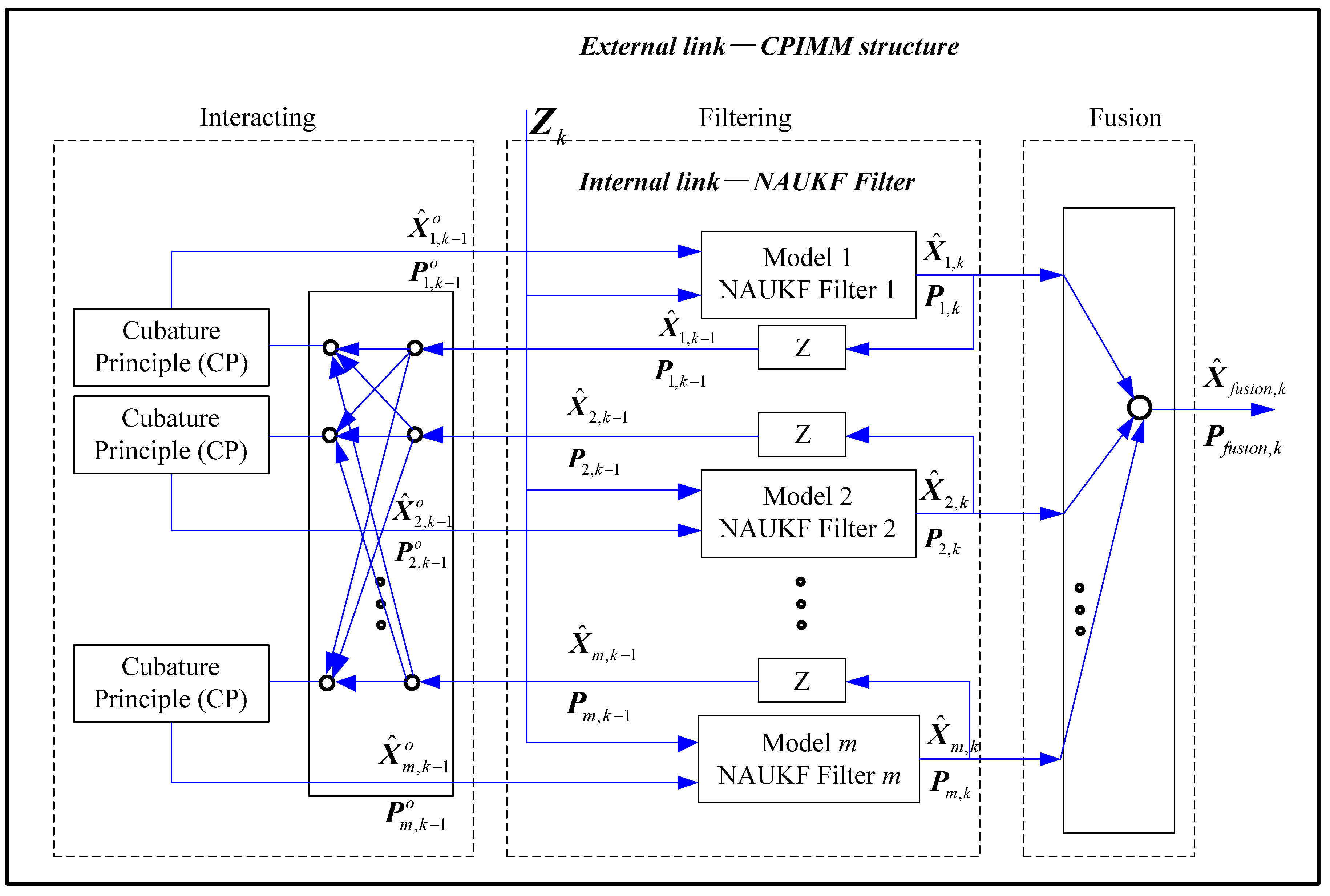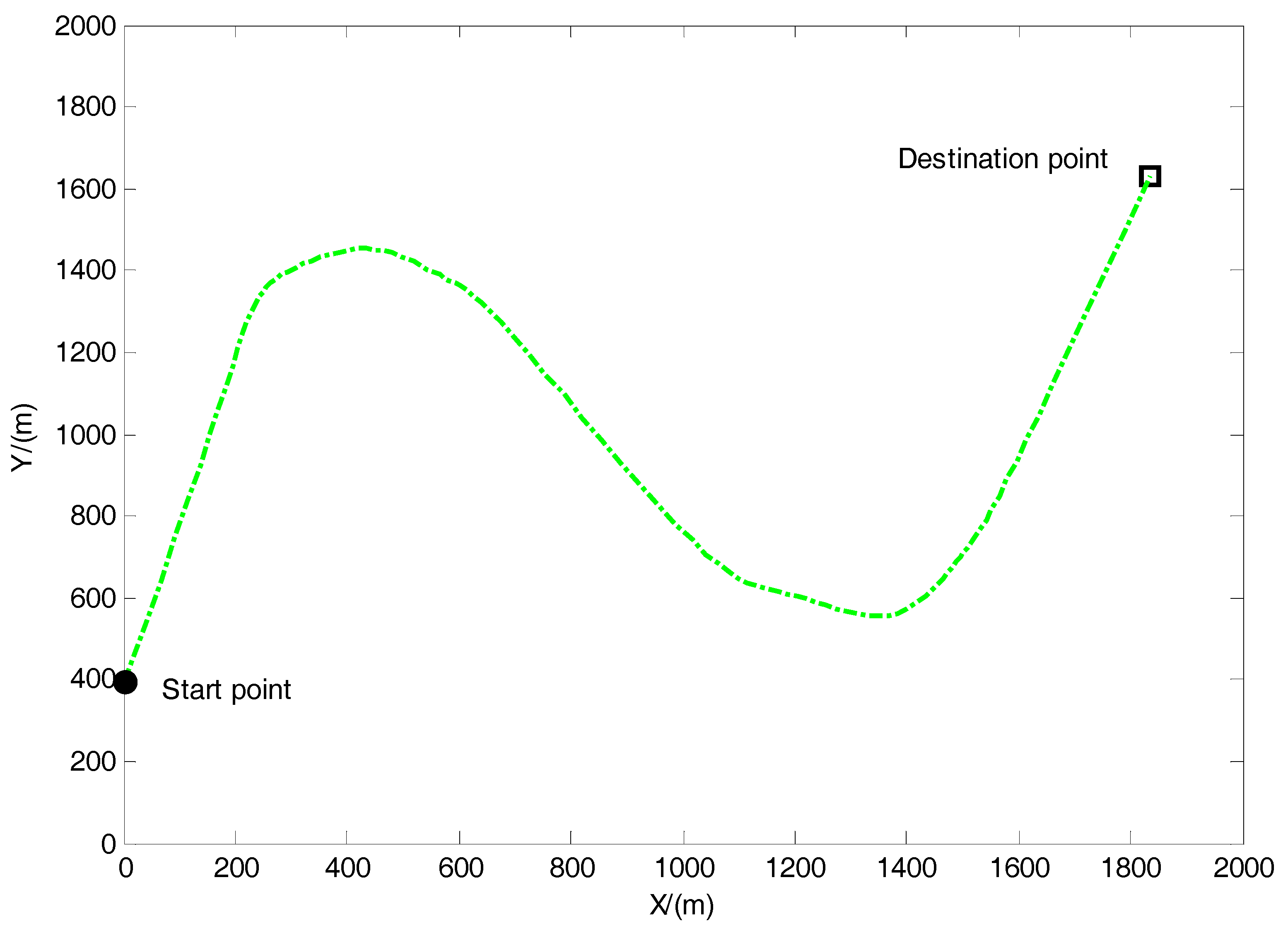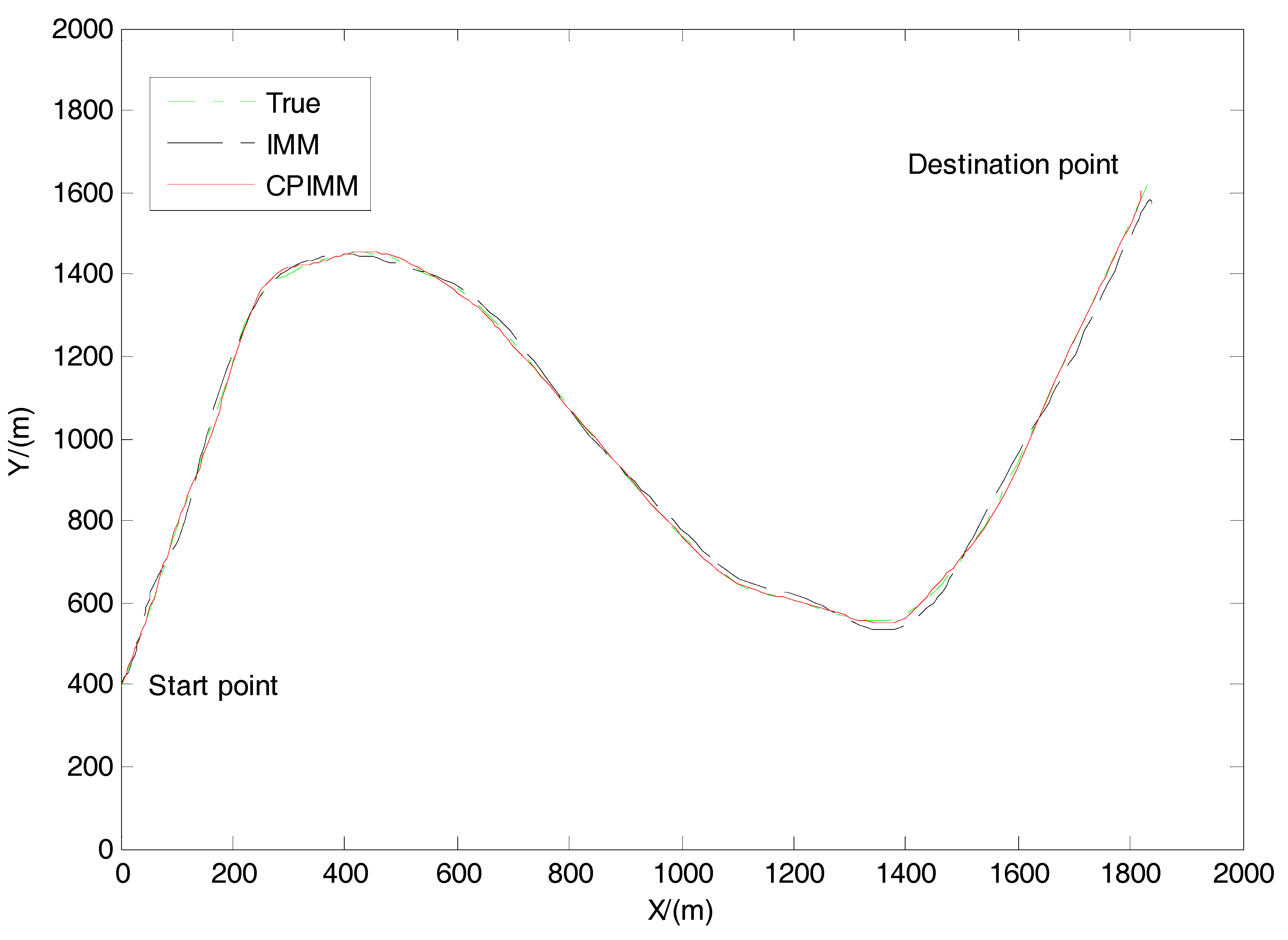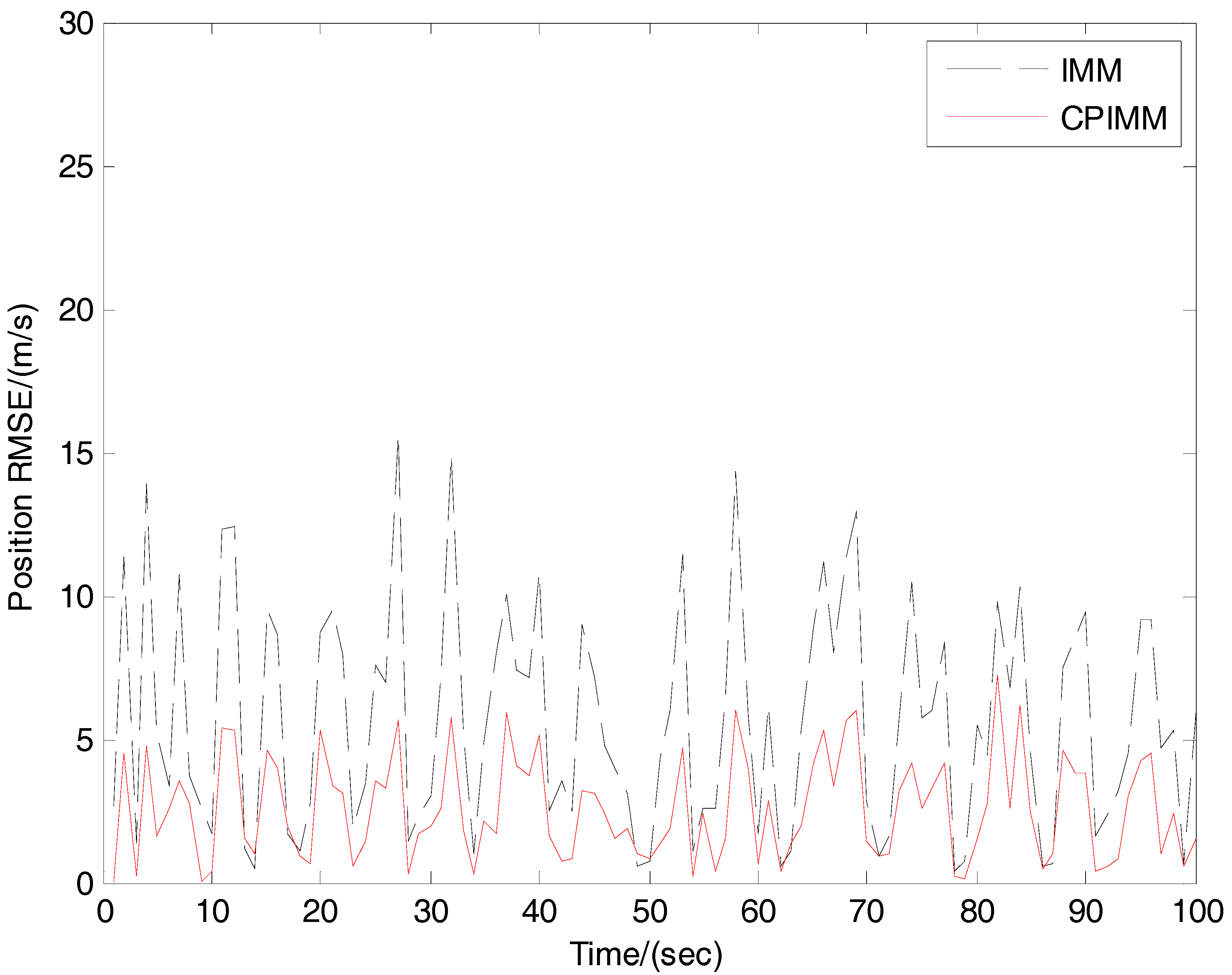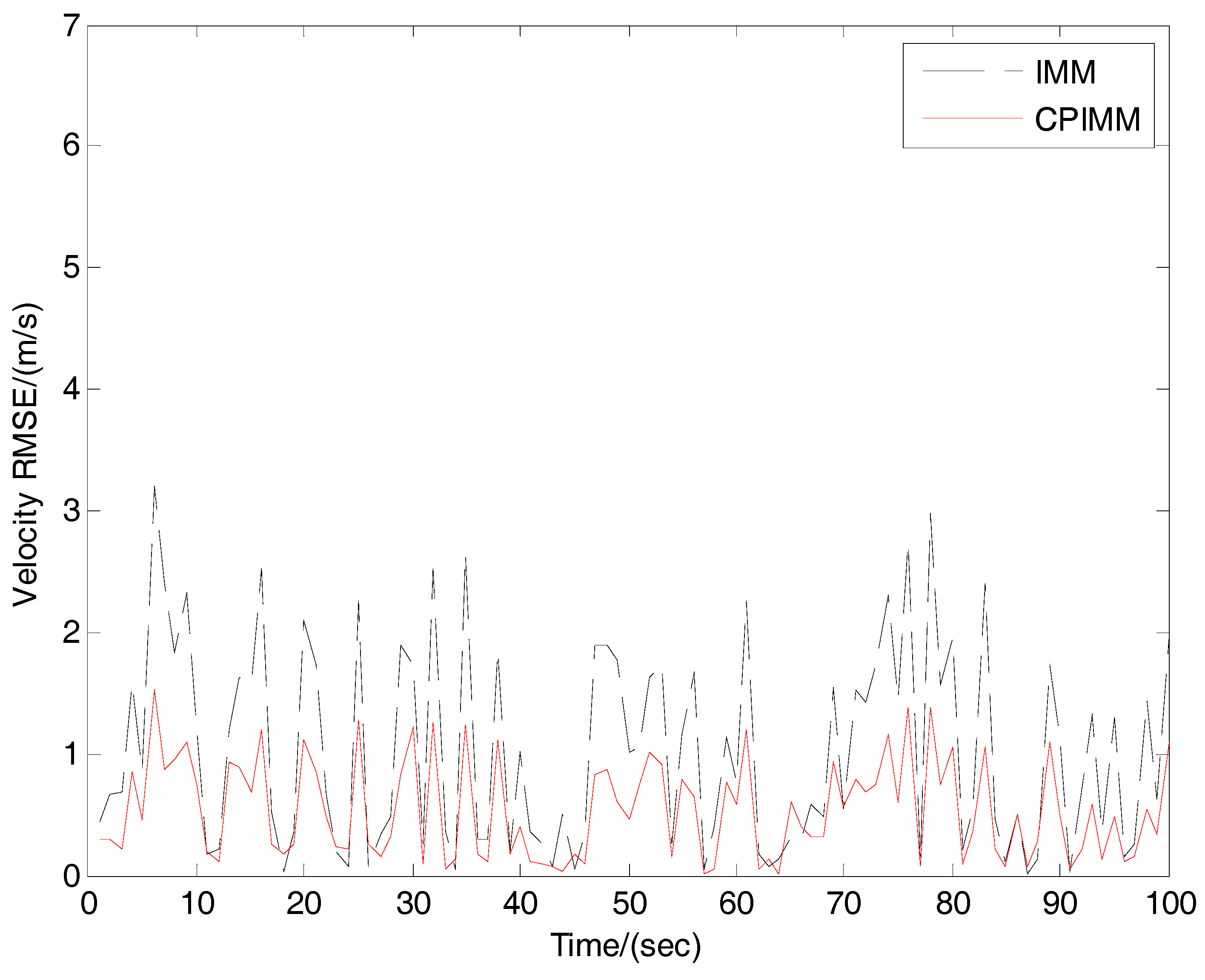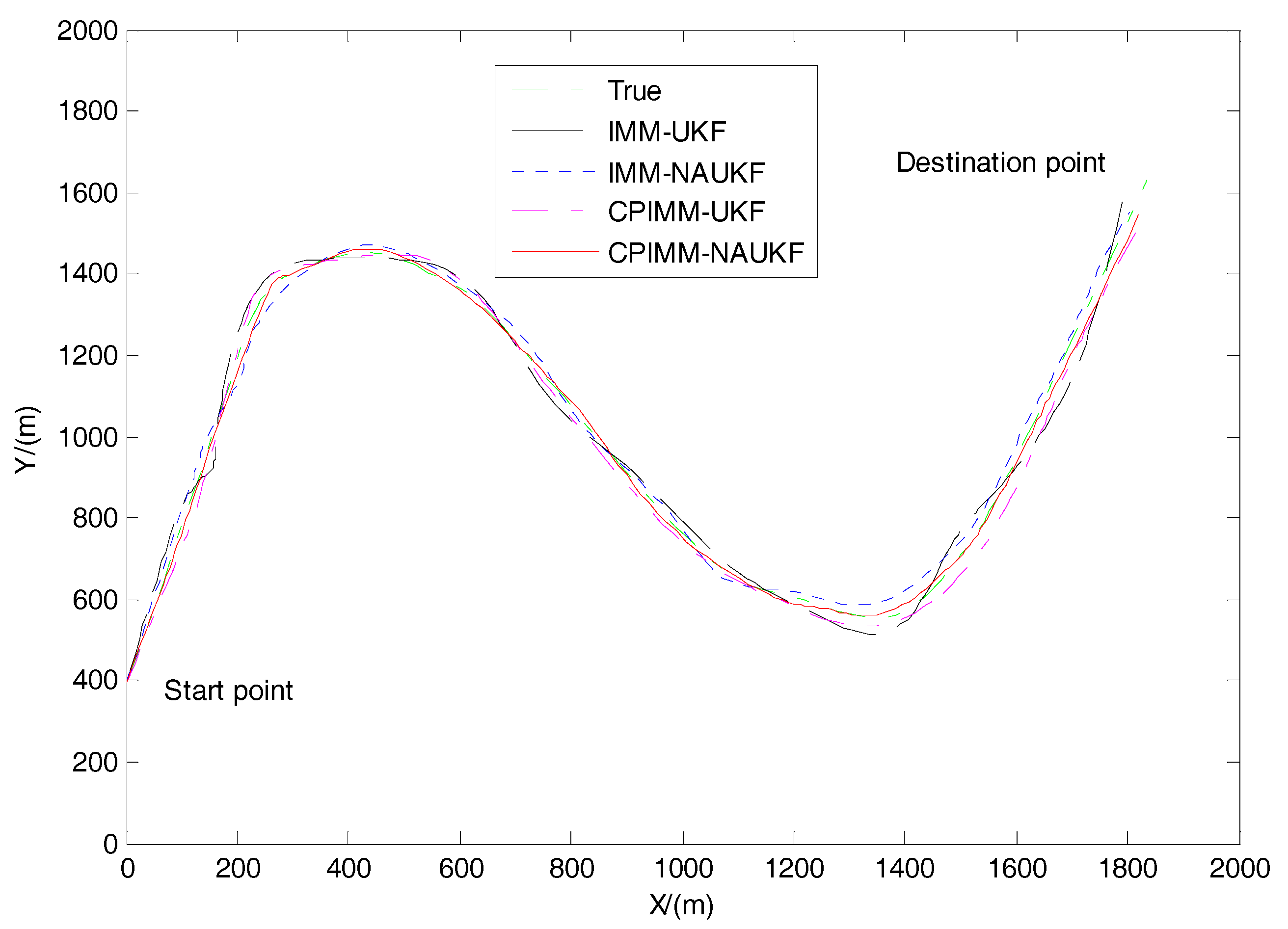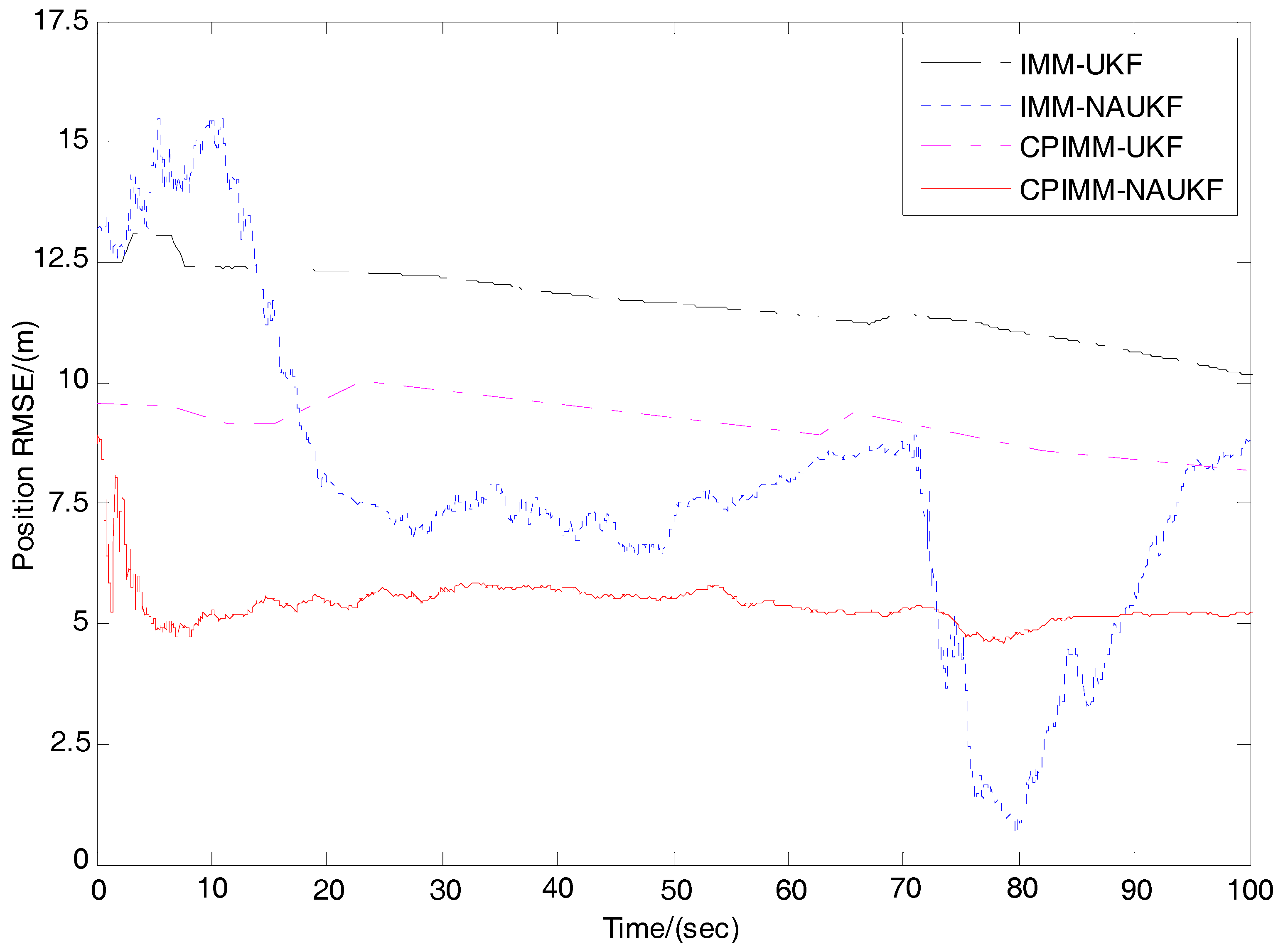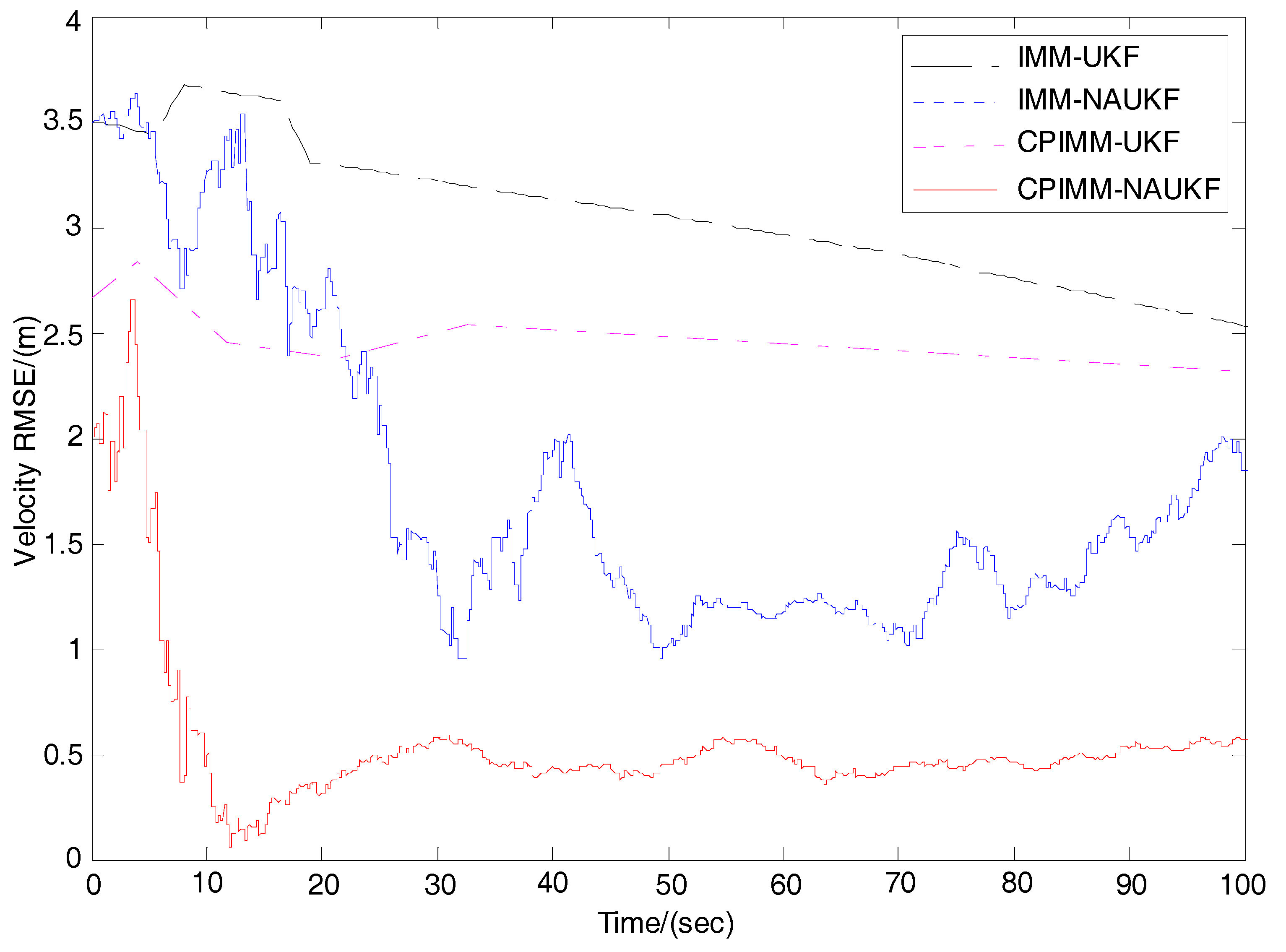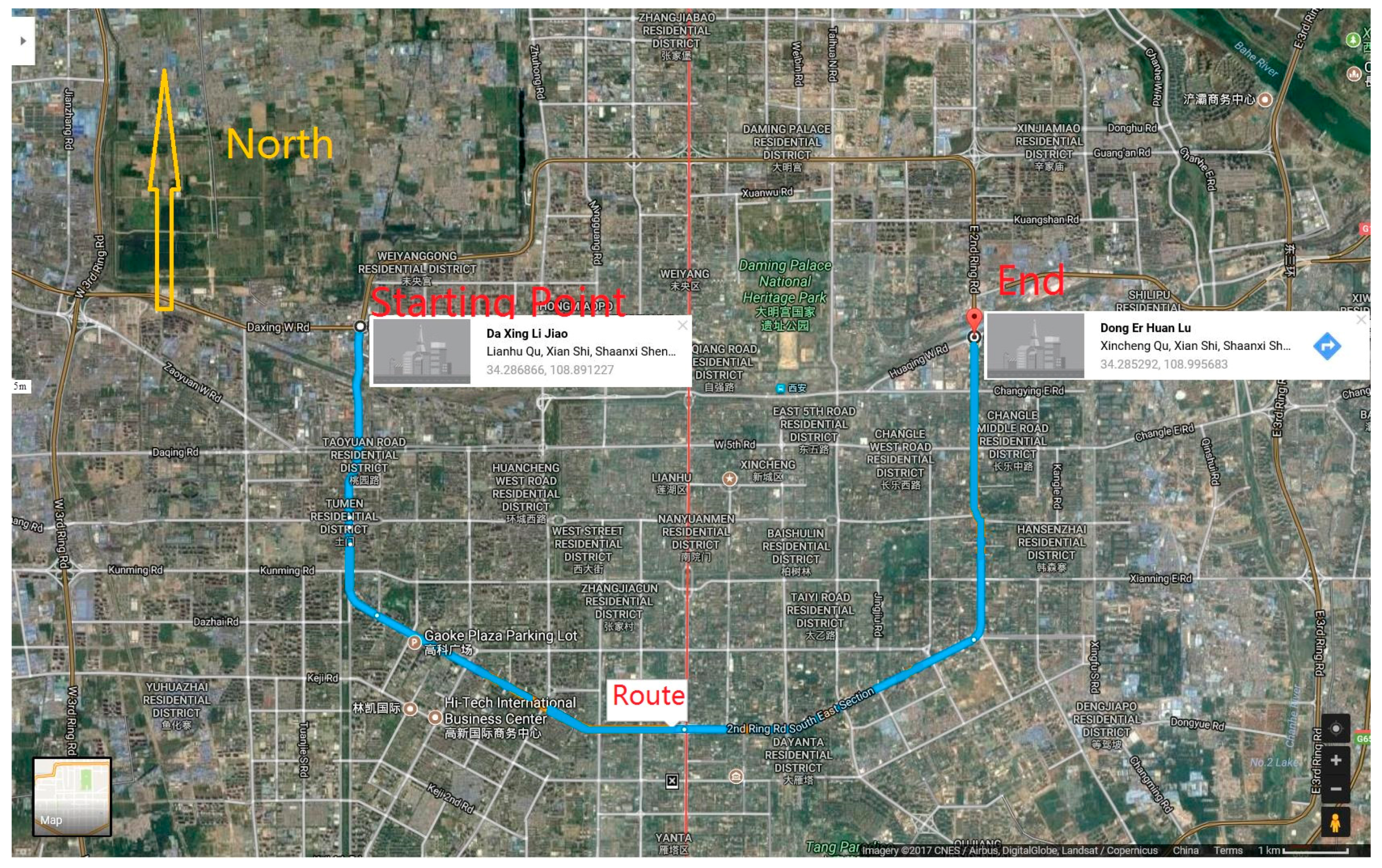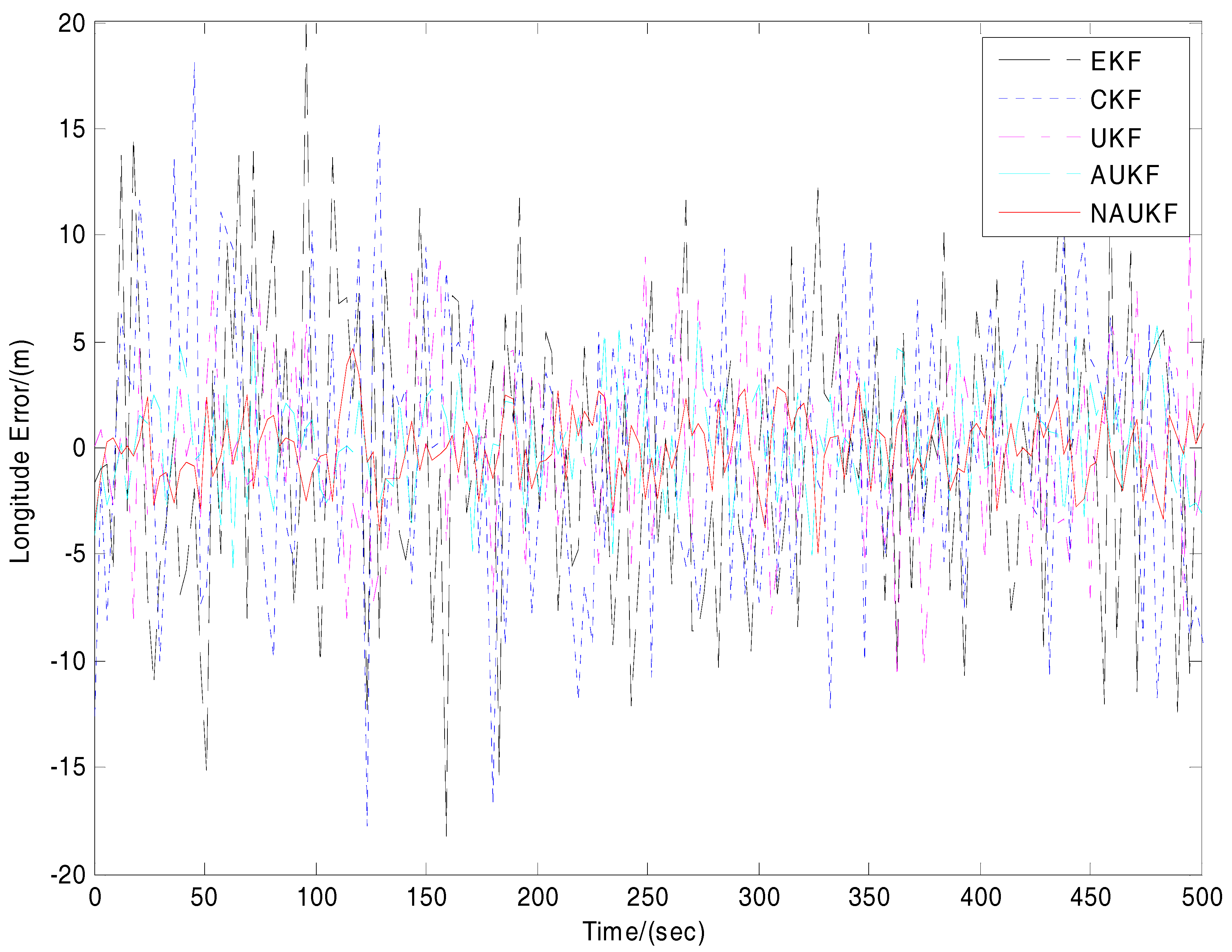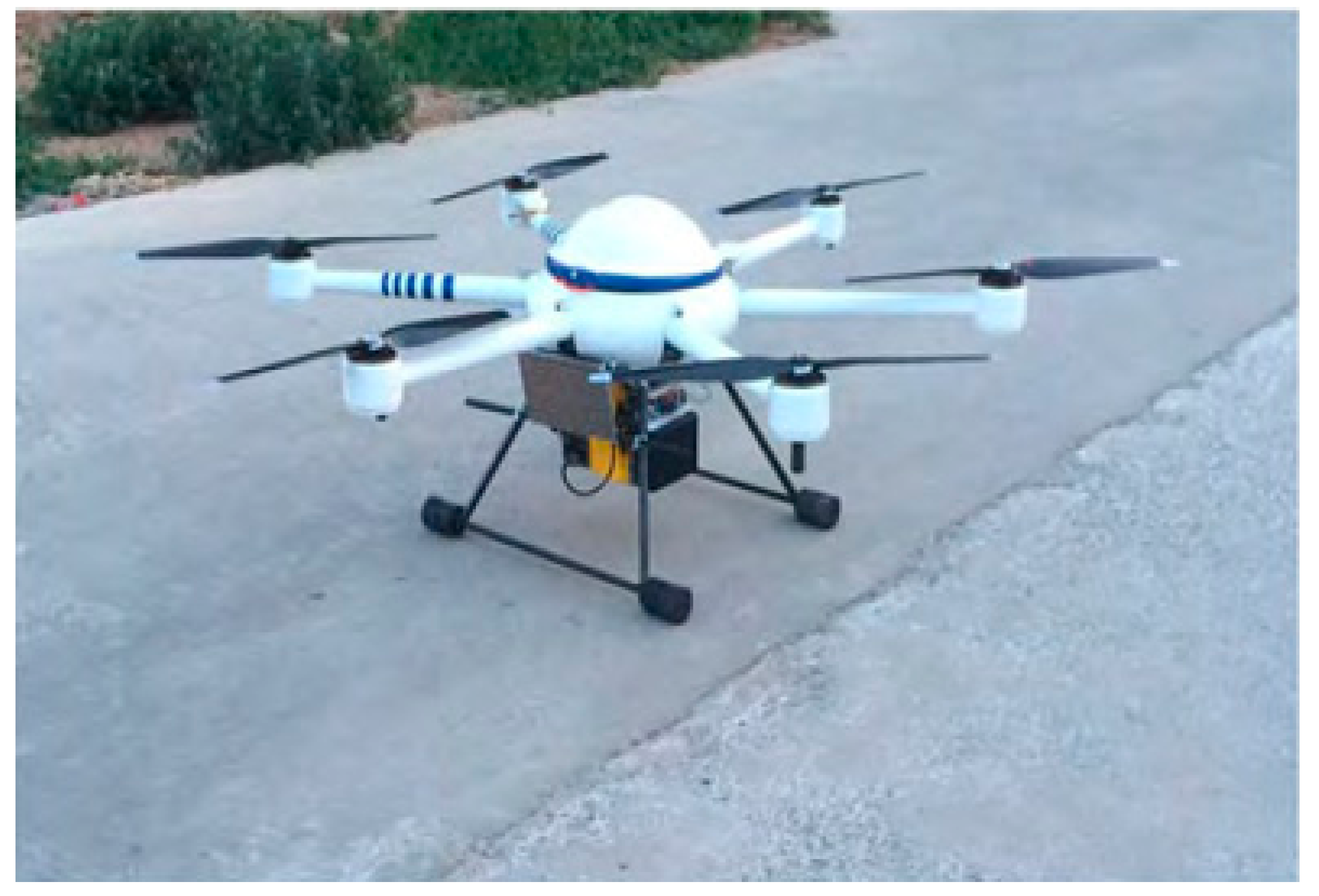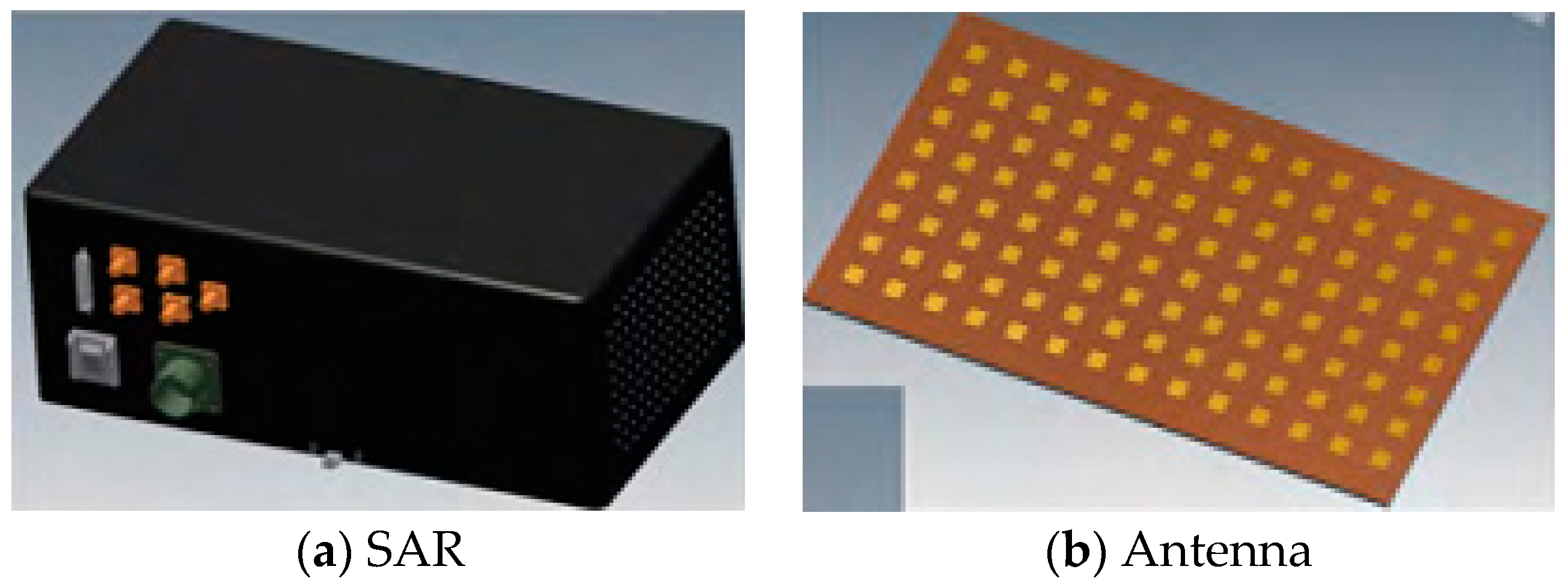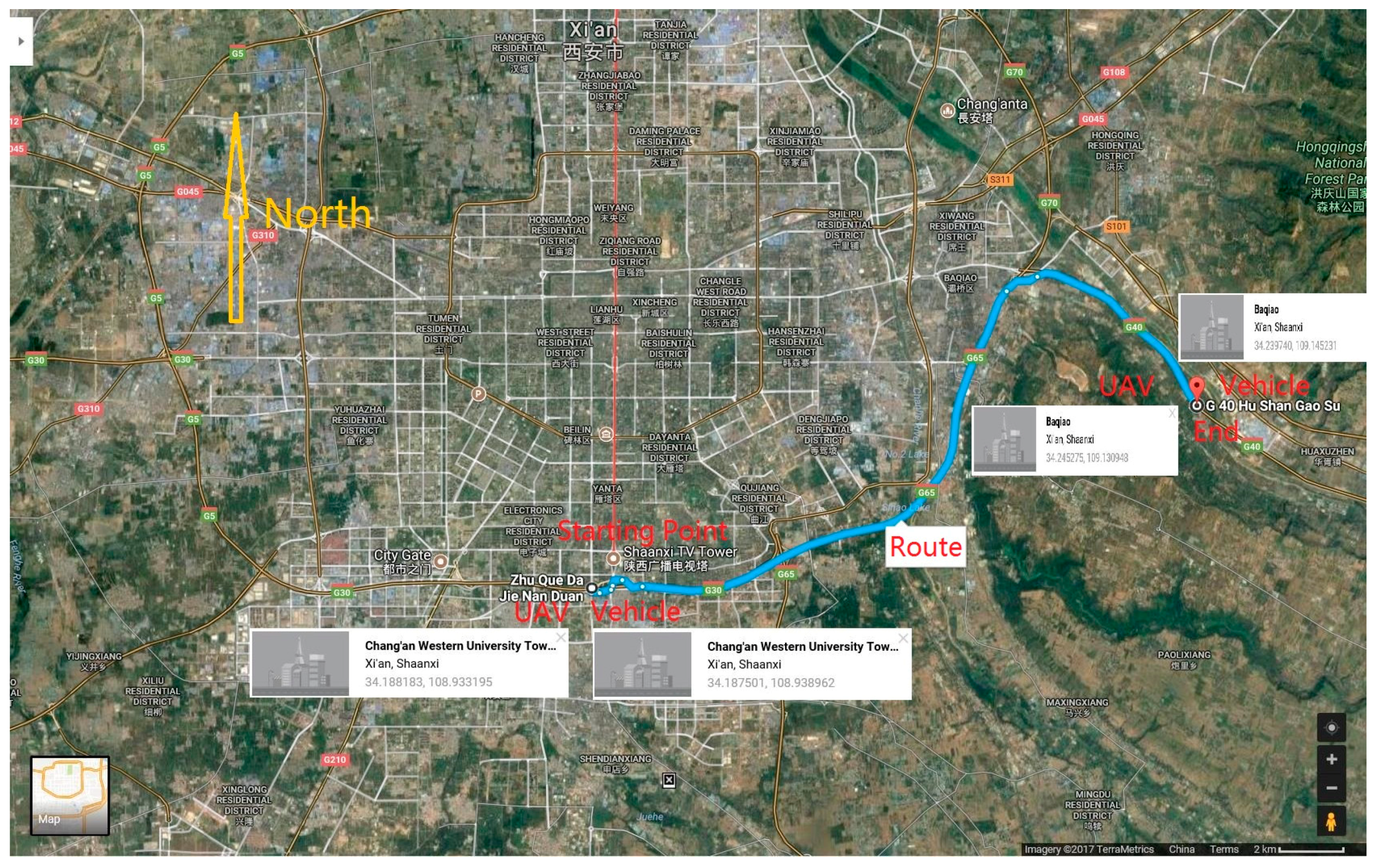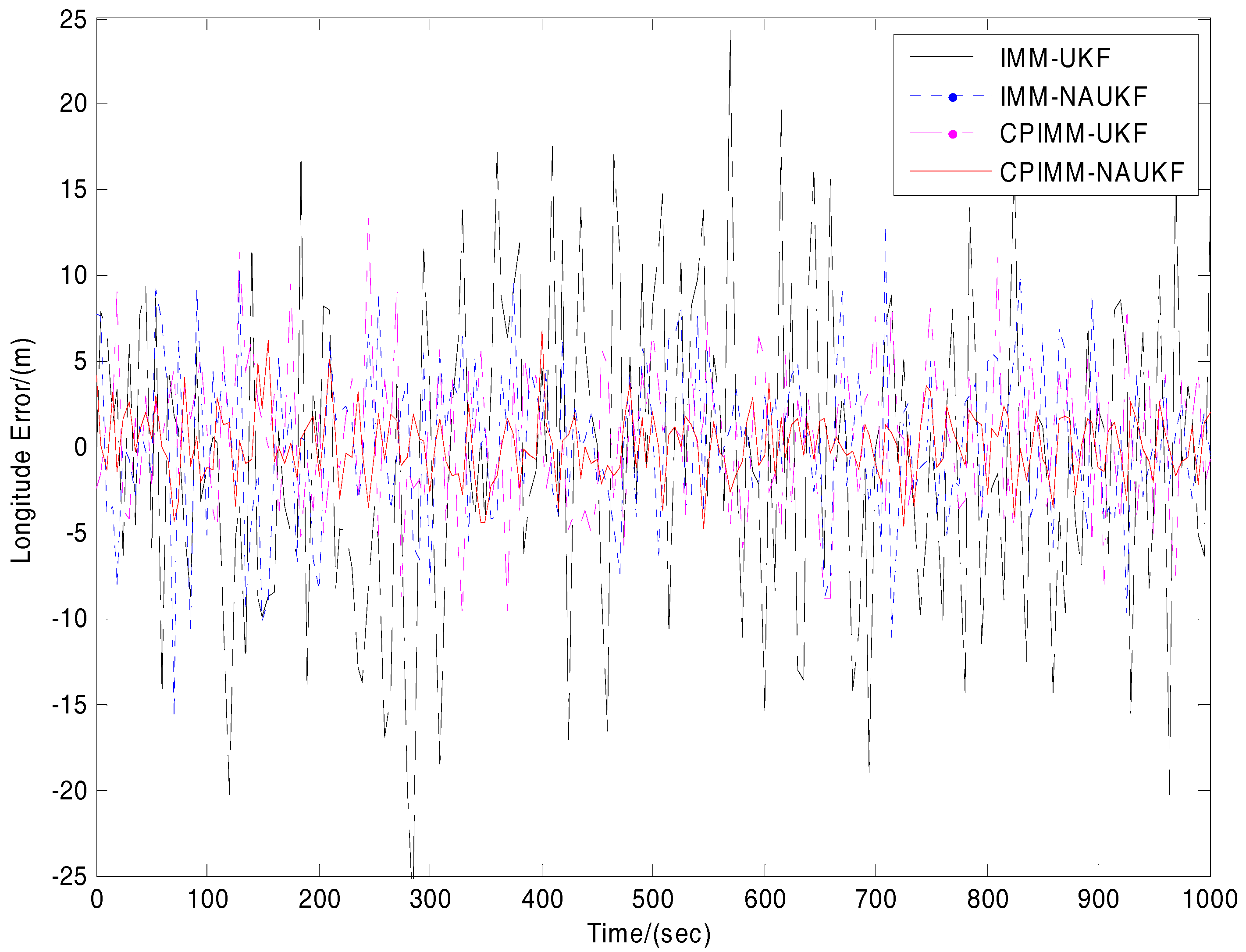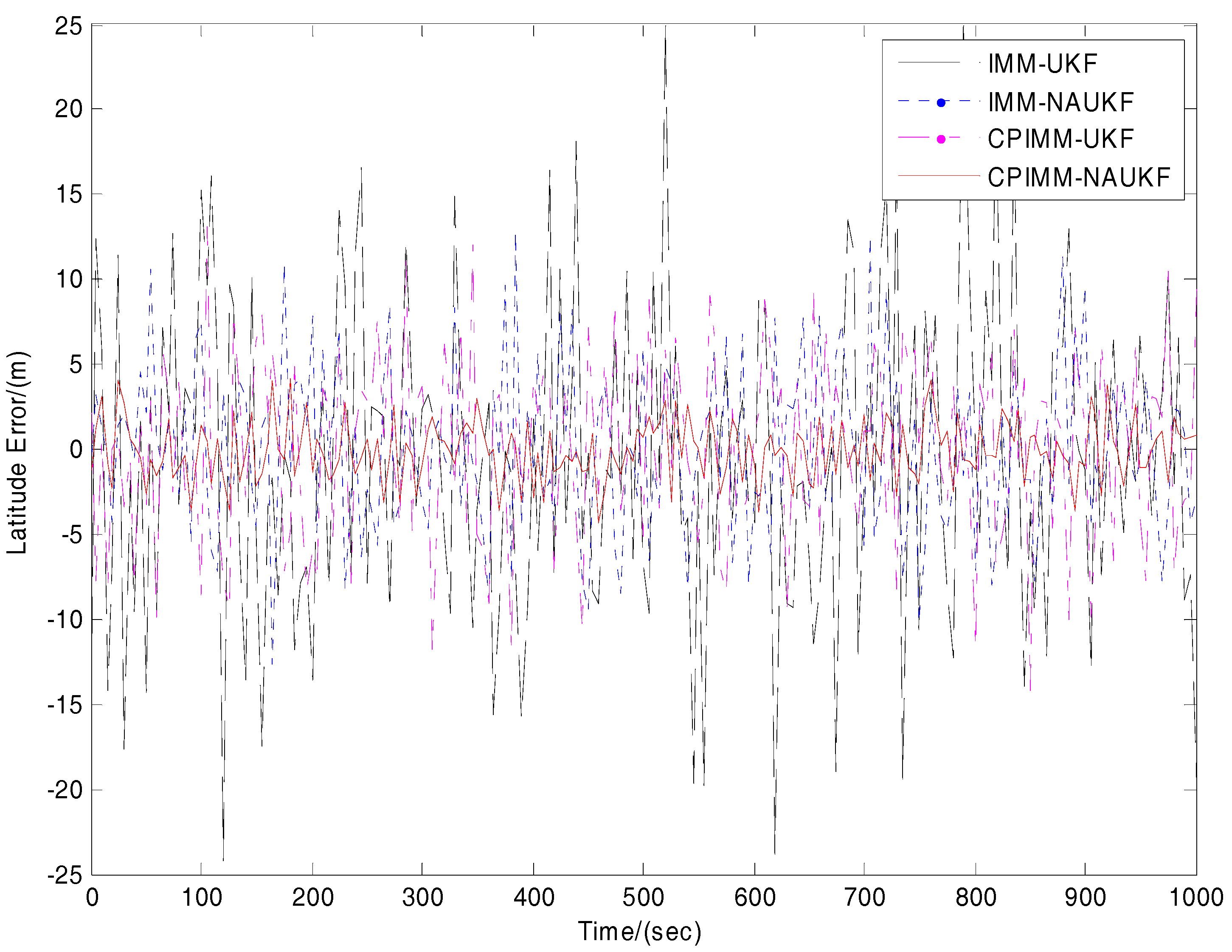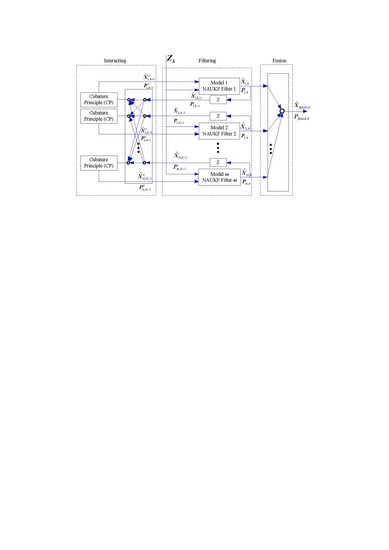1. Introduction
With the continuous development of space technology, maneuvering ability in real time is a key factor in completing complicated space missions for maneuvering targets [
1,
2,
3,
4]. Performing accurate maneuvering target tracking and precise locating are the core issues in the field of space target surveillance [
5,
6,
7,
8].
For maneuvering target tracking, the single model filter produces large filtering errors, and it is not appropriate for this application because the filtering algorithms highly depend on the motion model of the targets. The interacting multiple model (IMM) method integrates a variety of models to describe the motion rules of the targets, which improves the filtering precision. IMM was proposed by Blom and Barshalom [
9], and consists of three processes: interaction, filtering, and fusion. The interaction process is the core difference between IMM and the first generation of multiple model filters, called autonomous multiple model (AMM) filters [
10], which connect all the single filters organically to allow the “soft switching” between models. Due to the ability to automatically adjust the bandwidth of the filter, IMM has been widely used in navigation, positioning, signal processing, maneuvering target tracking, and other fields [
11,
12].
Based on the standard IMM, increasingly improved IMM algorithms have been created to further increase the filtering accuracy, including the Variable Structure Interactive Multiple Model (VSIMM) [
13], Adaptive Interactive Multiple Model (AIMM) [
14], and the Adaptive Grid Fuzzy Multiple Model (AGFIMM) [
15]. After analysis, the above algorithms are common for all dynamic adjustments of the multi-model set and for real-time conversions between multi-model sets, in order to adapt to the real-time signal change and to improve the filter’s precision.
However, when interacting, the weighted sum of multiple random variables will lead to multiple peaks in the probability density function of the system state, so the sum will not conform to the pure Gaussian distribution [
16,
17]. As a result, the filtering precision is negatively influenced for the non-Gaussian distribution. Two methods are used to address the problem. The Gaussian distribution can be used to approximate the non-Gaussian distribution [
18]. For example, Lainiotis uses the mean square error (MSE) to estimate the error covariance of the interacting random variable [
19], but the estimated value is too conservative. Because the MSE estimation results are used in the filter iteration, it artificially increases the system noise in the filtering process, which makes the calculation value of gain matrix too large. Therefore, the filtering precision decreases, especially with a large measured value of noise [
20]. The second method is to filter the results of the interaction by using non-Gaussian filters [
21]. For instance, the IMM-PF filtering method [
22,
23] can be used, but the particle filter (PF) causes problems, such as particle degradation and poor real-time performance, in engineering applications [
24,
25].
The unscented Kalman filter (UKF) is the most widely used algorithm with a single filter in the IMM [
26,
27,
28,
29,
30,
31,
32], and has many advantages compared to the Kalman Filter (KF), Extended Kalman Filter (EKF) [
33,
34], and PF. However, the tracking accuracy decreases significantly when sensor faults occur, because model mismatches are produced when the sensor receives measurements with biases [
35,
36,
37]. Generally, the sensor faults include four varieties: complete failure, fixed deviation, drift deviation, and accuracy decrease. The second and third faults are considered in this research. The current existing adaptive UKF has been proven to be effective in dealing with unknown noise, but no effective adaptive UKF algorithms exist for sensor faults and model mismatches [
38,
39].
Recently, Arasaratnam et al. [
40] proposed the cubature Kalman filter (CKF), based on the cubature principle, and provided rigorous mathematical proof. The cubature principle is the basis of CKF, and it computes the first and second order moments of the finite cubature points through nonlinear propagation, and then estimates the posterior probability density of the nonlinear system. As a typical deterministic sampling filtering algorithm, CKF has fewer sampling points and better numerical stability [
41]. As the mixed probability of IMM interaction varies with time, the interaction process is described by nonlinear equations, and the cubature principle in CKF is used to estimate the probability density function of a random variable after the interaction. To address the single model filtering precision problem, a new adaptive matrix gene is used in UKF together with the IMM method, to balance the contribution of the state and filtering results in the presence of sensor faults.
This paper develops a new efficient IMM-UKF algorithm for maneuvering target tracking, which addresses the non-Gaussian distribution problem and sensor faults. The IMM-UKF filtering problem is described for maneuvering target tracking with the occurrence of sensor faults. For IMM-UKF external links, the cubature principle (CP) is introduced to IMM to approximate the probability density of the random variable in the interaction, and the precision of the approximation is analyzed, which contributes to CP-assisted IMM (CPIMM). For IMM-UKF internal links, an adaptive matrix gene is integrated into traditional UKF to balance the contribution of the system state and provides filtering solutions, which is called a new adaptive UKF (NAUKF). Simulation and experiment results showed that the proposed cubature principle assisted IMM–adaptive UKF algorithm (CPIMM-NAUKF) has high filtering precision and fast convergence, and achieves better tracking performance than the existing IMM-UKF.
The remainder of this paper is organized as follows. The IMM-UKF filtering problem is described in
Section 2. The CPIMM-NAUKF is developed in
Section 3. Simulations and practical experiments comparing performance are conducted in
Section 4. Finally, the conclusions are provided in
Section 5.
3. Cubature-Principle-Assisted IMM-Adaptive UKF Algorithm (CPIMM-NAUKF)
By considering the internal and external link of IMM-UKF respectively, the cubature principle is introduced to the standard IMM, and an adaptive gene matrix is brought into the standard UKF.
For IMM, the most important factor on influencing the filtering precision is the non-Gaussian probability density function after the mixing interaction. It is the key to estimating the first moment and second moment of the random variables with high accuracy.
For adaptive UKF, one effective method is to balance contribution to UKF filtering solutions of the state information, measurement information, and innovation information.
3.1. CPIMM
3.1.1. Cubature Principle
Assuming that
, where the dimension of
is
, then the first moment and second moment of any function
can be solved by the following integral form:
Equation (13) is a multidimensional integral problem, and it is difficult to solve through analytic methods. The cubature principle states that a cubature point with a weighted value can be chosen to approximate the integral of the multidimensional function, and the method of choosing the cubature point is:
where
is the
rth column of the unit matrix
.
3.1.2. Estimating the Interaction by Using CP
Since the mixing probability varies with time, the interactive process is abstracted as a nonlinear function, and the cubature principle is used to approximate the probability distribution of the interacting random variables.
Firstly, the nonlinear function is used to describe the interaction process. The augmented system is constructed, where is a random variable with the dimension, and represents the state vector of the model ; ; . Assuming that is independent, and we have , the square root of the covariance matrix of is , and we have .
The next step is choosing cubature points for nonlinear propagation. The cubature points are selected by Equation (13), and
is rewritten as
, where
is the upper triangular matrix with all the diagonal elements being
;
is the value of the element on the diagonal of
, and the cubature points can be written as
where
is the
rth column of
.
The cubature points are calculated after the interaction by
Finally, according to the cubature principle, the mean and covariance matrix of
are obtained as
where
;
.
For the external IMM, shown by Equation (6) can be recalculated by Equation (18), and shown by Equation (7) can be recalculated by Equation (19); then, the newly obtained and are used in the iteration of the IMM filter, which leads to CP-IMM.
3.1.3. Accuracy Analysis of the CPIMM
In the literature [
22], the approximate precision of the mean of the Gaussian random variable after nonlinear propagation, by using the cubature principle, has been analyzed. In this section, the accuracy of the covariance matrix of the cubature principle will be analyzed.
Assume that
is the nonlinear mapping from
to
;
;
. If the Taylor series expansion of
is carried out at
with two derivatives, we have
where
is the Jacobian matrix with a
dimension;
represents
matrixes with
dimensions, which are called Hessian matrixes;
is the
Hessian matrix. Thus, we have
Calculating the first and second moments of Equation (20), we obtain
where
represents the trace of a matrix.
Equation (18) can be rewritten as
Substituting Equation (23) to (19), and assuming
, we have
When
is correct by considering the selection process of cubature points shown in Equation (17), we have
Substituting Equation (25) into Equations (23) and (24), respectively, we obtain
Equations (22) and (26) show that the mean and covariance estimates can achieve second-order accuracy of a Taylor series expansion using the cubature point to create a random variable through the nonlinear function. The one-dimensional case in
Section 2.3 is used to illustrate that the mean value obtained by the cubature principle is 0.6, and the covariance is 1.3826, which is much closer to the results obtained by Monte Carlo method than the MSE method.
3.2. New Adaptive Unscented Kalman Filter (NAUKF)
Motivated by the proposed UKF algorithm, we propose a new adaptive UKF (NAUKF) consisting of an adaptive matrix gene. , and represent the corresponding covariance computed by the standard UKF, and they are changed into , and in the NAUKF.
Theorem 1. On the basis of standard UKF, set up a new adaptive matrix gene asLetwhere is calculated from the Sigma points in the standard UKF; is the innovation; denotes the weighted coefficient [3];
; and is the covariance of ; Then the NAUKF can address the filtering problem in the presence of sensor faults shown by Equation (2). Proof: Because model mismatches exist in the system shown by Equation (2), based on Theorem 1, the result is
where
.
After setting up
shown by Equation (27), we have
From Equations (29) to (31), we know that the third-order precision conditions can be satisfied, which means that the NAUKF can be used for the system that has sensor faults. This completes the proof.
To avoid the divergence problem of NAUKF, a covariance matching criterion is used:
where
(
) is a preset adjustable coefficient.
If Equation (32) is satisfied, the NAUKF has been convergent;
should be updated with an adaptive weighted coefficient
by increasing the contribution of
on the filtering solutions.
where
is set by
3.3. Implementation Steps of the CPIMM-NAUKF Algorithm
Step 1: NAUKF filtering process.
First, calculate the covariance by setting
and
of the standard UKF, and compute
. Next, select the new adaptive gene selection by setting up
through Equation (27), and recalculate
with Equation (28)
To determine the convergence strategy, judge the divergence according to Equation (32). If it is satisfied, go directly to the next step; otherwise, update by using Equations (33)–(35).
Next, to obtain the NUKF filtering results, use the following:
From Equations (38) and (39), obtain the , , …, and for UKF filters to of IMM-UKF.
Step 2: The CPIMM filtering process.
First, compute the mixing probability. Calculate the mixing probability according to Equation (3). Next, determine the Interaction by using CP. After , , …, and are obtained based on Step 1, calculate and , respectively, with Equations (18) and (19). Then update the model probability by calculating the mixing probability according to Equation (5). To complete the fusion, calculate resultant mean and covariance matrix with Equations (8) and (9).
4. Experimental Results and Discussion
To verify the effectiveness of the maneuvering target tracking of the proposed CPIMM-NAUKF, numerical simulations and practical experiments are both conducted. For the numerical simulation, two sets of experiments were simulated: (1) the standard IMM [
9] and CPIMM algorithms; (2) the IMM-UKF [
43], IMM-NAUKF connecting the standard IMM with NAUKF, CPIMM-UKF connecting the CPIMM with standard UKF, and CPIMM-NAUKF algorithms. The experimental environment was set as Intel i7 computer with 4-core, 64-bit, 2.4 GHz, 8 GB RAM, and MATLAB R2013a software. For the practical experiments, an integrated navigation system and a synthetic aperture radar (SAR) tracking system using the CPIMM-NAUKF algorithm are, respectively, shown to test the proposed method with real data.
4.1. Numerical Simulations and Analysis
To design the simulation scenarios, suppose that
represents the state of the maneuvering target, including the position and velocity. The sensor is the radar, and its position is fixed at the coordinate origin. Thus, the measurement equation is
where
and
are the distance and angle measurement components of the radar, respectively.
The high-speed maneuvering target moves in a two-dimensional scenario with 100 s; the initial position is [0 m, 400 m], and the initial velocity is [10 m/s, 40 m/s]; the target moves at a constant velocity in a straight line from 0 s–20 s, with a constant right turn rate being −0.1 rad/s from 20 s–40 s, constant velocity in a straight line at 40 s–60 s, constant left turn with the turn rate being 0.1 rad/s at 60 s–80 s, and a constant velocity in a straight line at 80 s–100 s. In a Cartesian coordinate system, the true trajectory of the maneuvering target is depicted in
Figure 4.
Both the IMM and CPIMM include three models: one Constant Velocity (CV) model [
44] and two Coordinated Turn (CT) models [
44].
For the CV model, the state transition matrix is
where
T is the sampling period, and
T = 1 s.
The process noise is calculated with
where
denotes the covariance of the process noise, and
.
For the CT model, the state transition matrix is
where
is the turn rate.
The process noise meets with
where
denotes the covariance of the process noise, and
.
The two models use the following transition and mode probabilities.
The transition probability matrix is
The initial mode probability matrix is
The measurement covariance is .
Case 1 is where the sensor has no faults and is in a normal work situation. Case 2 is when the sensor has faults, and , where and represents the distance deviation within [−5 m, 5 m] and the angle drift rate within , respectively.
Every simulation experiment is tested 100 times using Monte Carlo, and algorithms of two sets of comparison simulations are evaluated by root mean square error (RMSE), which is computed through
where
and
are the estimated and true state in the
simulation, respectively;
is the number of simulations;
.
4.1.1. CPIMM Simulation
To validate the effectiveness of CPIMM, the first set of comparisons, including the standard IMM and CPIMM, was simulated. We assumed there were no sensor faults, similar to the Simulation Case 1 in the scenario design section.
Figure 5 gives the true and estimated trajectories of the maneuvering target. As seen in
Figure 5, both CPIMM and IMM can track the trajectory of the target.
The comparisons of the RMSE position and velocity curves of the two filtering algorithms are shown in
Figure 6 and
Figure 7, and the corresponding statistical data of RMSE are listed in
Table 2. The filtering precision of the IMM is lower than the CPIMM, although the IMM is not divergent. The CPIMM greatly increases the filtering precision compared with IMM. In addition, this means that the tracking performance of CPIMM is higher than that of the IMM, because the cubature principle is used to increase the estimation values in the interaction process of the IMM.
4.1.2. CPIMM-NAUKF Simulation
To validate the effectiveness of CPIMM-NAUKF, the second set of comparisons, including the IMM-UKF, IMM-NAUKF, CPIMM-UKF, and CPIMM-NAUKF were simulated, assuming there are sensor faults, similar to Simulation Case 2 in the scenario design section.
Figure 8 gives the true and estimated trajectories of the maneuvering target. Both CPIMM and IMM can track the trajectory of the target, but the estimated trajectory of CPIMM-NAUKF was closest to the true trajectory.
The comparisons of the RMSE position and velocity curves of four filtering algorithms are shown in
Figure 9 and
Figure 10, and the corresponding statistical data of RMSE are listed in
Table 3. The sensor faults negatively influenced the filtering precision of the UKF and the filtering error of the standard IMM-UKF was the largest. The IMM-NAUKF has better filtering accuracy than the IMM-UKF, because the internal link NAUKF effectively handled the sensor fault problem, but the filtering convergence performance was poor. The CPIMM-UKF also has better filtering accuracy than the IMM-UKF because the internal link CPIMM has a better effect for maneuvering target tracking than IMM, but the filtering accuracy relationship between IMM-NAUKF and CPIMM-UKF does not exist. Ultimately, CPIMM-NAUKF has the best filtering accuracy, since it significantly improves the IMM-UKF through the external and internal links, which makes it extremely effective for maneuvering target tracking when sensor faults occur.
In summary, as a combination of CPIMM and NAUKF, the CPIMM-NAUKF, compared with the existing IMM-UKF, makes a greater contribution to filtering performance in terms of accuracy and convergence speed. This is because it includes two important links, the external CPIMM and the internal NAUKF, which work simultaneously and effectively.
4.2. Practical Experiments and Analysis
Furthermore, to demonstrate the effectiveness of the proposed CPIMM-NAUKF method for real applications, two practical experiments were conducted. An unmanned aerial vehicle (UAV) was loaded with an Inertial Navigation System (INS)/Global Positioning System (GPS) integrated navigation system for its navigation and positioning, and equipped with an SAR tracking system to track the maneuvering targets.
4.2.1. INS/GPS Integrated Navigation System
As shown in
Figure 11 and
Figure 12, the vehicle loaded integrated navigation system included a NV-IMU300 type INS, a JAVAD Lexon-GGD112T type GPS receiver, and a NovAtel DL-V3 GPS receiver on the vehicle, and another NovAtel DL-V3 GPS receiver was located at the Earth Reference Station. The working frequency of the GPS was 20 Hz. The maximum distance between the vehicle and the Earth Reference Station had to be less than 60 km, which ensured that the positioning precision of the vehicle was better than 0.1 m.
Let the geographic coordinate system be the navigation coordinate system with three directions of East, North, Up. Define the system states as
where
represent the heading angle, the pitch angle, and the roll angle of the vehicle, respectively;
are components of the velocity along the East, North, and Up directions, respectively;
are components of the position along the East, North, and Up directions, respectively;
represent the drift of the gyro;
represent the bias of the accelerator.
The state space model is
the concrete equations of which can be found in [
45].
Select the velocity and position outputs of the GPS as the measurement variables:
where
are components of the velocity measured via GPS along the East, North, and Up directions, respectively;
are components of the position measured via GPS along East, North, and Up directions, respectively. The velocity and position information measured via GPS can be used as a reference to confirm the position error of the INS/GPS.
The measurement equation is
where
.
In the experiment process, the initial position was as follows: East longitude 108.891227°, North latitude 34.286866°, and an altitude of 437.92 m. Components of the velocity along the East, North, and Up directions were, respectively, −8 m/s, −35 m/s, and 0 m/s; the drift of the gyro was 0.12°/h, and the white noise was 0.02°/h; the bias of the accelerator was 10
−3 g, and the white noise was 10
−4 g; the positioning and position precision of the GPS were 5 m and 0.05 m/s; the other initial parameters were the same as the those described in the simulation section. The experiment test time was designed as 500 s with the sample period being 1 s, and the end point of the vehicle was East longitude 108.995683°, North latitude 34.285292°, and an altitude of 438.01 m. The practical road condition was the urban highway, and the real route of the vehicle is shown in
Figure 13.
Five filtering methods including standard EKF [
33], CKF [
40], standard UKF [
27], existing adaptive UKF (AUKF) [
38], and NAUKF were used in the experiment, and these algorithms were evaluated by the estimation error rather than RMSE, which is computed through
The comparisons of the longitude and latitude error curves of five filtering algorithms are shown in
Figure 14 and
Figure 15, and the corresponding statistical data of the mean absolute error are listed in
Table 4. We can see that the EKF and CKF have almost the same filtering accuracy, although both EKF and CKF can deal with the nonlinear filtering problems—they only have first order accuracy. The filtering errors are, respectively, [−18.1025, 19.9471] m and [−17.5118, 18.4296] m of the longitude error ranging, and [−20.1143, 16.2477] m and [−17.4154, 14.9953] m of the latitude error ranging. The standard UKF has better filtering precision than does EKF and CKF, because UKF can reach third order accuracy, but it still has substantial oscillation and error due to the longitude error ranging [−11.0549, 10.2178] m and latitude error ranging [−9.1766, 9.9737] m. The AUKF has the adaptive ability of the imprecise noise in the urban complex environment, so it has better filtering accuracy than the UKF with the longitude error ranging [−5.8142, 6.0273] m and latitude error ranging [−8.1184, 6.4153] m. Ultimately, NAUKF has the best filtering accuracy, with the longitude error ranging [−4.1109, 4.3804] m and latitude error ranging [−6.1096, 4.7138] m, since it can not only adapt to the noise but also the sensor faults and model mismatches.
In summary, UKF has better filtering precision than KF, EKF, and CKF, because UKF can reach third order accuracy. The proposed NAUKF has the best filtering performance in terms of precision and dynamic response for its adaptive ability to both imprecise noise and sensor faults, and it can increase the precision and adaptability of the navigation system effectively.
4.2.2. SAR Tracking System
As shown in
Figure 16 and
Figure 17, the UAV is equipped with one D3160 type SAR. The UAV is a six-rotor UAV with mass being 20 kg and velocity range being 0 m/s–20 m/s. The D3160 type SAR is a kind of micro-SAR system and the parameters are as follows: mass: 4 kg, operating frequency band: X or Ku, detection range: 10 km, resolution: 0.3 m.
The SAR can detect the pitch angle
, azimuth
and distance
of the target vehicle relative to the UAV, and the measurement equation is
where
is the position of UAV;
is the position of the target vehicle.
In the experiment process, both the pitch angle and azimuth measurement had the drift rate, and the distance measurement had the deviation for the SAR, but the precise statistics about the sensor faults and noises are still unknown. In
Figure 18, the target vehicle is driving on the expressway, and the initial position of the UAV and the target vehicle is, respectively, East longitude 108.933195°, North latitude 34.188183°, and an altitude of 1.50 km and East longitude 108.938962°, North latitude 34.187501°, and an altitude of 436.05 m. The experiment test time is designed as 1000 s with the sample period being 1 s, and the end point of the UAV and the target vehicle is, respectively, East longitude 109.130943°, North latitude 34.245275°, and an altitude of 1.50 km and East longitude 108.145231°, North latitude 34.239740°, an altitude of 436.76 m.
When the IMM and CPIMM methods are used, the target model description is the same as the numerical simulation. Four filtering methods including IMM-UKF, IMM-NAUKF, CPIMM-UKF, and CPIMM-NAUKF were used in the experiment, and these algorithms were evaluated by the estimation error shown by Equation (50).
The comparisons of the longitude and latitude error curves of five filtering algorithms are shown in
Figure 19 and
Figure 20, and the corresponding statistical data of the mean absolute error are listed in
Table 5. We can see that the standard IMM-UKF has the biggest filtering error with the longitude error ranging [−25.0223, 24.8762] m and latitude error ranging [−23.9917, 24.9834] m. The IMM-NAUKF has better filtering precision than IMM-UKF because of the adaptive ability to the sensor faults with the longitude error ranging [−16.1849, 14.0871] m and latitude error ranging [−13.8628, 14.0563] m. The CPIMM-UKF has better filtering precision than IMM-UKF because of the adaptive ability to the non-Gaussian distribution with the longitude error ranging [−10.0547, 14.2482] m and latitude error ranging [−14.7196, 12.2544] m. The CPIMM-NAUKF has the best filtering accuracy, since it can not only adapt to the non-Gaussian but also the sensor faults and model mismatches with the longitude error ranging [−5.0018, 6.8623] m and latitude error ranging [−4.8007, 4.9106] m.
In summary, the practical experiments results demonstrate that the proposed CPIMM-NAUKF is obviously superior to the existing IMM and UKF algorithms in terms of filtering precision and dynamic response for its adaptive ability to both non-Gaussian and sensor faults, and it can significantly improve the precision and robustness of the maneuvering target tracking system.


